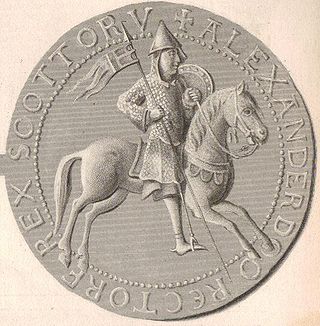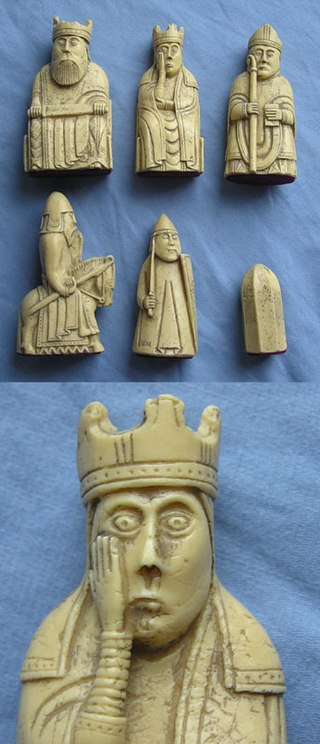Related Research Articles

Alexander I, posthumously nicknamed The Fierce, was the King of Scotland from 1107 to his death. He succeeded his brother, King Edgar, and his successor was his brother David. He was married to Sybilla of Normandy, an illegitimate daughter of Henry I of England.
Malcolm III was King of Scotland from 1058 to 1093. He was later nicknamed "Canmore". Malcolm's long reign of 35 years preceded the beginning of the Scoto-Norman age. Henry I of England and Eustace III of Boulogne were his sons-in-law, making him the maternal grandfather of Empress Matilda, William Adelin and Matilda of Boulogne. All three of them were prominent in English politics during the 12th century.
Donnchad mac Máel Coluim was King of Scots. He was son of Malcolm III and his first wife Ingibiorg Finnsdottir, widow of Thorfinn Sigurdsson.

Malcolm IV, nicknamed Virgo, "the Maiden" was King of Scotland from 1153 until his death. He was the eldest son of Henry, Earl of Huntingdon and Northumbria and Ada de Warenne. The original Malcolm Canmore, a name now associated with his great-grandfather Malcolm III, he succeeded his grandfather David I, and shared David's Anglo-Norman tastes.

Cináed mac Maíl Coluim was King of Alba (Scotland) from 971 to 995. The son of Malcolm I, he succeeded King Cuilén on the latter's death at the hands of Rhydderch ap Dyfnwal in 971.

Donald III was King of Scots from 1093 to 1094 and 1094–1097. He was known as Domnall Bán or "Donald the Fair", anglicized as Donalbain.
Cináed mac Duib, anglicised as Kenneth III, and nicknamed An Donn, was King of Alba (Scotland) from 997 to 1005. He was the son of Dub. Many of the Scots sources refer to him as Giric son of Kenneth son of Dub, which is taken to be an error. An alternate explanation is that Kenneth had a son, Giric, who ruled jointly with his father.

Máel Coluim II, was a 13th-century Mormaer of Fife who ruled the mormaerdom or earldom of Fife between 1228 and 1266. He was the nephew of Máel Coluim I, the previous mormaer, and the son of Máel Coluim I's brother Donnchadh, son of Donnchadh II.
Máel Coluim of Atholl was Mormaer of Atholl between 1153/9 and the 1190s.

Fearchar of Ross or Ferchar mac in tSagairt, was the first of the Scottish Ó Beólláin family who received by Royal Grant the lands and Title of Mormaer or Earl of Ross (1223–1251) we know of from the thirteenth century, whose career brought Ross into the fold of the Scottish kings for the first time, and who is remembered as the founder of the Earldom of Ross.
Moray was a province within the area of modern-day Scotland, that may at times up to the 12th century have operated as an independent kingdom or as a power base for competing claimants to the Kingdom of Alba. It covered a much larger territory than the modern council area of Moray, extending approximately from the River Spey in the east to the River Beauly in the north, and encompassing Badenoch, Lochaber and Glenelg in the south and west.
The House of Moray or Clann Ruaidrí is a historiographical and genealogical construct to illustrate the succession of rulers whose base was in Moray and who ruled sometimes a larger kingdom, mainly the Kingdom of Scotland. An important feature of Scottish politics throughout the 11th century, they reached the height of their power with the reign of Macbeth between 1040 and 1057.
Mormaer Beth is a name of a Mormaer mentioned in an unreliable charter granted to Scone Priory, later Scone Abbey, by king Alexander I of Scotland.
William fitz Duncan was a Scottish prince, the son of King Duncan II of Scotland by his wife Ethelreda of Dunbar. He was a territorial magnate in northern Scotland and northern England and a military leader.

The High Middle Ages of Scotland encompass Scotland in the era between the death of Domnall II in 900 AD and the death of King Alexander III in 1286, which was an indirect cause of the Wars of Scottish Independence.
The Meic Uilleim (MacWilliams) were the Gaelic descendants of William fitz Duncan, grandson of Máel Coluim mac Donnchada, king of Scots. They were excluded from the succession by the descendants of Máel Coluim's son David I during the 12th century and raised a number of rebellions to vindicate their claims to the Mormaerdom of Moray and perhaps to the rule of Scotland.

Harald Maddadsson was Earl of Orkney and Mormaer of Caithness from 1139 until 1206. He was the son of Matad, Mormaer of Atholl, and Margaret, daughter of Earl Haakon Paulsson of Orkney. Of mixed Norse and Gaelic blood, and a descendant of Scots kings, he was a significant figure in northern Scotland, and played a prominent part in Scottish politics of the twelfth century. The Orkneyinga Saga names him one of the three most powerful Earls of Orkney along with Sigurd Eysteinsson and Thorfinn Sigurdsson.
Gille Coluim the Marischal was an official of the Scottish crown in the second half of the 12th century. His name occurs in the witness lists of two extant charters, both issued by King William of Scotland at Perth, which indicates that he was probably a native of somewhere in southern Perthshire. He seems in fact to have been the lord of Madderty in Strathearn. In either 1172 or 1173 he witnessed King William's grant of Ardross to Merleswain mac Cholbaín, a relative of the mormaer of Fife.; and somewhere between 1178 and 1185 he witnessed the king's grant of lands in Inverness-shire to Gille Brigte, Mormaer of Strathearn. In both of these charters, the grants are to native Scots and Gille Coluim appears alongside other native Scots, such as Gille Críst mac ingine Samuel and Gille Míchéil mac Donnchada. Gille Coluim in both cases appears with the title "Marescal", meaning that he was the king's military commander. It appears to be in this role that Gille Coluim was given control of the castle at Auldearn ("Heryn") in Moray during a rebellion by the Meic Uilleim, a royal kindred who were claiming the throne of Scotland. A charter issued by King William at Linlithgow, between 1187 and 1189 grants Gille Brigte, mormaer of Strathearn, the land of Madderty and states that neither Gille Coluim nor his heirs have any right to the land after giving up Auldearn to the Meic Uilleim. In the charter, King William declares that Gille Coluim
"feloniously surrendered my castle of Heryn and then went over to my mortal enemies in the manner of a wicked traitor and stood with them against me to do as much harm as he could".

Political and military events in Scotland during the reign of David I are the events which took place in Scotland during David I of Scotland's reign as King of Scots, from 1124 to 1153. When his brother Alexander I of Scotland died in 1124, David chose, with the backing of Henry I of England, to take the Kingdom of Alba for himself. David was forced to engage in warfare against his rival and nephew, Máel Coluim mac Alaxandair. Subduing the latter took David ten years, and involved the destruction of Óengus, mormaer of Moray. David's victory allowed him to expand his control over more distant regions theoretically part of the Kingdom. In this he was largely successful, although he failed to bring the Earldom of Orkney into his kingdom.
Máel Coluim mac Alaxandair was an illegitimate son of Alexander I of Scotland, and was an unsuccessful pretender to the Scottish throne. He is a relatively obscure figure owing primarily to the scarcity of source material, appearing only in pro-David English sources, which label him a "bastard".
References
- Barrow, G.W.S., Kingship and Unity: Scotland, 1000–1306. Reprinted Edinburgh University Press, Edinburgh, 1989. ISBN 0-7486-0104-X
- Duncan, A.A.M., The Kingship of the Scots 842–1292: Succession and Independence. Edinburgh University Press, Edinburgh, 2002. ISBN 0-7486-1626-8
- Grant, Alexander, "The Province of Ross and the Kingdom of Alba" in E.J. Cowan and R. Andrew McDonald (eds.) Alba: Celtic Scotland in the Medieval Era. Tuckwell Press, East Linton, 2000; reprinted John Donald, Edinburgh, 2005. ISBN 0-85976-608-X
- Mackay, Angus. (1906). The Book of Mackay . (St Andrews University). Printed by William Rae, Wick.
- McDonald, R. Andrew, Outlaws of Medieval Scotland: Challenges to the Canmore Kings, 1058–1266. Tuckwell Press, East Linton, 2003. ISBN 1-86232-236-8
- Oram, Richard, David I: The King Who Made Scotland. Tempus, Stroud, 2004. ISBN 0-7524-2825-X